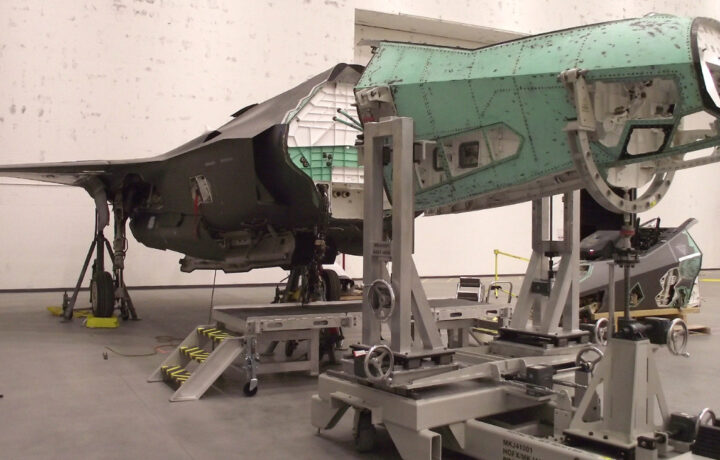The plot of the 1965 film The Flight of the Phoenix (remade in 2004) involved a small group of survivors of an aircraft crash landing building a new plane from the wreckage. A fair amount of “suspension of disbelief” is required when viewing the film (even more with the remake), but now, the United States Air Force is engaged in a similar project.
It doesn’t involve a crashed aircraft in the middle of nowhere, and instead of jury-rigging the pieces back together, it actually involves a trained team and arguably one of the most advanced combat aircraft in modern service. Maintenance experts for the Lockheed Martin F-35 Lightning II at Hill Air Force Base (AFB), Utah, are now stitching two mishap damaged aircraft together into a restored – and hopefully fully operational – aircraft.
The project, which is being led by the F-35 Joint Program Office (JPO) has called upon a “dream team” of uniquely qualified individuals from the office, the 388th Fighter Wing, the Ogden Air Logistics Complex and Lockheed Martin.
“This is a first for the F-35 program and a very exciting project,” said Dan Santos, F-35 JPO heavy maintenance manager.
Work began on the feasibility of this project in January 2020, after the F-35 JPO reached out to Lockheed Martin, which previously accomplished a restoration projects for its F-22 Raptor.
The Franken-bird Project
The effort has been built on experience gained from several recent salvage aircraft re-purpose projects – including the stand-up of the first F-35 maintainer training facility using salvaged aircraft sections, as well as the partial restoration of a salvaged F-35 airframe for use as an ABDR trainer.
The F-35 JPO is now taking the effort a step further, and with a newly established network of skilled professionals, resources and facilities, all of which are located at Hill AFB, it is undertaking the “Franken-bird” project.
Following a feasibility study, the F-35 JPO sought to reconstruct the AF-211 aircraft, which had experienced a nose landing-gear separation in June 2020. It will receive an undamaged nose section from AF-27, which suffered a serious engine fire six years earlier at Eglin AFB, Florida. That latter aircraft has been serving as an Air Force Air Battle Damage and Repair trainer at Hill AFB.
The JPO is building on its experience as it has reused parts from damaged Lightning IIs in maintenance and operations for several years, but this is taking the refurbishment efforts quite further. The Ogden Air Logistics Complex has played a significant role by providing hangar space and heavy equipment for the project.
“It takes a team to make these types of endeavors successful,” Santos added. “I am very impressed with the collaborative efforts from the various agencies across Hill AFB, working together to make this happen.”
To complete the work on site at Hill AFB, entirely new, unique specialized tooling, fixtures and equipment had to be designed and built, and specifically adapted for mobility. Many of the tools and other equipment were developed to be transportable to various locations, including forward operation areas.
These could have potential future uses abroad, given that the F-35 is in service with more than a dozen allied and partner nations.
A Future Case Study?
The F-35 JPO-led program has been taking meticulous documentation, which could be used to establish standardized F-35 procedures that can be seamlessly integrated into routine operations in the future.
“All of the aircraft sections can be de-mated and re-mated theoretically, but it’s just never been done before,” said Scott Taylor, Lockheed Martin lead mechanical engineer.”This is the first F-35 ‘Franken-bird’ to date. This is history.”
Hopefully, even with the lessons learned, the JPO won’t have future opportunities to do this again – at least not anytime soon.
There have been twenty-nine F-35 crashes to date – with the first occurring in February 2013, while the most recent was in September, when the pilot was forced to eject. That latter aircraft was even temporarily “lost” near Charleston, South Carolina.
While the F-35 has amassed more than 721,000 cumulative flight hours, and more than 965 have been delivered, the prospect of losing any is the sort of thing that will give any government bean counter serious troubles. The F-35, in addition to being one of the most capable warbirds in service, is also the most expensive aircraft currently being produced.
The Franken-bird project is currently several months ahead of schedule and showing a completion date of March 2025.



